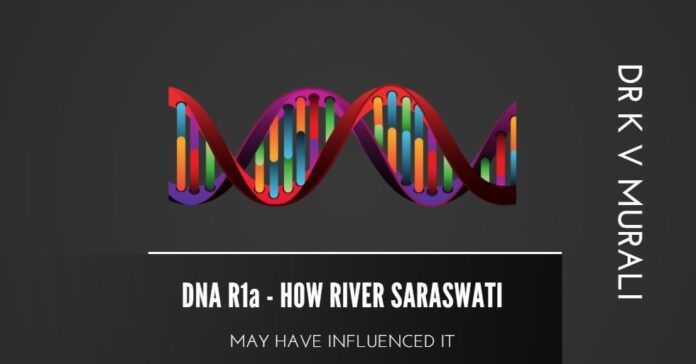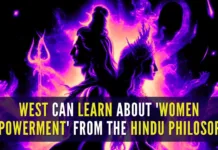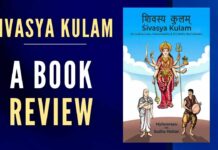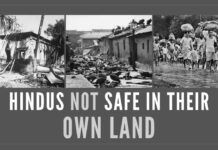
This is the concluding part of the series Early Steppe vs Middle to Late Steppe in which the author disputes the theory of David Reich and his team at Harvard on the Aryan-Dravidian Theory.
Ancient (Archeo-Paleo-) Climatology
The Indian monsoon system is at any given time strongest in the east or the west of India, but not both. This is a phenomenon well known to most climatologists. One of the major reasons that the Indus Valley Civilization (IVC) declined is the drying up of river Saraswati. The river was supported by both monsoons and Himalayan glaciers melting. Thus flowed the mightiest of mighty rivers with two plentiful sources to support it. Apt is the description of it in the Rig Veda, a river likened to the ocean. (Danino 2010) This was when the monsoons were stronger over the west of India.
The east of India, particularly the south of India becomes arid when this phase is on, which lasts for a few thousand years and then the monsoons swap to the east making the west (Rajasthan and Thar desert) arid. Climatologists do not know why this happens, but they know it is a phenomenon that exists – the monsoons swapping between the east and the west of India every few thousands of years. In fact, when it is strong in the west almost the entire Arabian sea (before the Christian European Colonial times it was known as the Indian sea) coast can benefit from it.
Even after the monsoons moved over to the east, river Saraswati was feeding the IVC extremely well to allow for civilisational development without much risk of massive flooding though (archaeologically called the mature phase of IVC). Even though IVC is named after Indus, it is highest density and its archaeological centre lies in the now dry river bed of Ghaggar-Hakra river (that is river Saraswati). But an earthquake caused a tectonic shift, which led to a feeding tributary of the river from the Himalayas to shift its course to the Yamuna river basin. This dealt the final blow to possibly the densest part of the IVC, river Saraswati basin. And, of course, people migrated out of the now arid region. (Priyadarshi 2014, 2011)
This is likely the source for the R1a lineages starting to appear in Steppe_MLBA samples in the study by Reich and Co.
If you remember from the above, the monsoon has, long before IVC declined, shifted to the south and east of India. When this happens, agriculture and industry flourishes and population naturally expands. Expanding populations tend to migrate out, for trade or for want of better pastures from the ensuing overcrowding from the population growth. As the Yamuna–Gangetic plain was already occupied and dense, their obvious next stop will have been further north. This might have brought in further R1a lineages into Steppe_MLBA and Steppe_LBA. (Priyadarshi 2014, 2011)
| Till date, one of the global characteristics of the Indian population, especially the South Indian (that too Tamizh) population, is that they have historically produced the most expatriates. From the Chola reign all over South East Asia to the recent Burmese businesses of Tamizh origin to the current day non-resident Indians (NRIs). It is perhaps in the Indian genes to peacefully explore, settle, integrate and prosper. (Priyadarshi 2014, 2011) |
The South Indian Chettiar (Vysya) communities dominated trade and banking in the entire globe, because they controlled the entire Asian banking industry, the production hub of the world’s economy even during Christian British White colonial times. This was terminated by the Nehru-Indira economic policy and only then did the Jewish community take over the pole position that they currently hold in the banking and finance industry of the globe, enabling the shift of capital centres from the East to the West. One cannot resist wondering if Reich’s personal self-hatred and insecurities, as a Jewish person-by-origin, extends to his ancestors predecessors-in-ranking, the Vysyas? He writes scathingly about the Chettiars elsewhere, under the guise of scientific writing for the lay audience – that is, his recent book of dubious scientific merit.
A Word about Sampling and Choosing the Right Controls
Say, if a researcher wants to test the hypothesis whether Americans are on an average healthier than Indians. Assume, the researcher goes to a gym in New York and picks up his sample participants for the study, and in India he goes to an old age home and picks up his sample. He is going to invariably end up with a conclusion that Americans are more healthy. Though the example here is too obvious there are subtler and more difficult to identify versions of such situations in sampling for research. In fact, in genetics since the data are just letters (that is DNA code – A, T, G and C), the chances of even missing the most obvious sampling and other errors is much higher than in medical research or other fields of science. In the above study of Reich and co, the control group is Andamanese, not even mainland Indians. Of course, they do have Indian samples from all over India. But, just adding a very distantly related population (in time and geography) will skew the results to no end.
The author has often noticed, but could be wrong because of a non-random and small sample size (perhaps even a bias on the author’s side), these kinds of errors is more common in the biological sciences – the most common errors being inadequate sample size, application of inappropriate statistics (statistical software in computers are just tools: garbage in, garbage out, GIGO) and poor selection of controls. Often times, due to a greater scrutiny on clinical sciences (perhaps owing to the direct impact on patients’ lives) the researchers there tend to be better trained in statistics (biostatistics).
Unfortunately, it is easy to hide behind the numbers. In this case, it is being done extremely well by the Harvard team and its Indian sepoys. The foundational base for this genetic-data storytelling was laid long back and has now come to full fruition. As always, Indians have been caught completely unprepared, not only ill-prepared. There is hardly any scientist in India or elsewhere who could help the truth. It appears, as in the case of the scientist quoted in the Open Magazine, enticing fellowships and niceties have already been handed out to many and the entrenchment of the propaganda camp in the Indian sciences is well secured, for now.
(The numerical, statistical, flaws in this and other genetic studies will be published separately, perhaps an academic technical article, by the author and his team.)
(Many thanks to Shri Sudarshan T Nadathur for reviewing the draft)
Note:
1. The views expressed here are those of the author and do not necessarily represent or reflect the views of PGurus.
REFERENCES
- Baker, M. (2016). 1,500 scientists lift the lid on reproducibility. Nature, 533(7604), 452–454. https://doi.org/10.1038/533452a
- Basu, A., Sarkar-Roy, N., & Majumder, P. P. (2016). Genomic reconstruction of the history of extant populations of India reveals five distinct ancestral components and a complex structure. Proceedings of the National Academy of Sciences of the United States of America, 113(6), 1594–1599. https://doi.org/10.1073/pnas.1513197113
- Chavda, A. (n.d.). What Reich’s Study Says And Doesn’t About How Indians Came To Be. Retrieved April 29, 2018, from https://swarajyamag.com/ideas/what-reichs-study-says-and-doesnt-about-how-indians-came-to-be
- Danino, M. (2010). The Lost River: On the Trail of the Sarasvatī. Penguin Books India. Retrieved from https://market.android.com/details?id=book-8yc7-OirxKEC
- Kivisild, T., Rootsi, S., Metspalu, M., Mastana, S., Kaldma, K., Parik, J., … Villems, R. (2003). The genetic heritage of the earliest settlers persists both in Indian tribal and caste populations. American Journal of Human Genetics, 72(2), 313–332. https://doi.org/10.1086/346068
- Malhotra, R. (n.d.). Introduction to Rajiv Malhotra’s Vocabulary – Infinity Foundation. Retrieved April 29, 2018, from https://infinityfoundation.com/course/rajiv-malhotra-vocabulary/
- Murali KV. (2018, April 29). There are lies, damned lies and (Harvard’s “Third” Reich and Co’s) statistics – PGurus. Retrieved April 29, 2018, from https://www.pgurus.com/there-are-lies-damned-lies-and-harvards-third-reich-and-cos-statistics/
- Priyadarshi, P. (2011). The First Civilization of the World. Siddharth Publications. Retrieved from http://www.amazon.in/First-Civilization-World-Priyadarshi-P/dp/8172202059?_encoding=UTF8&portal-device-attributes=desktop&psc=1&redirect=true&ref_=oh_aui_detailpage_o04_s00
- Priyadarshi, P. (2014). In Quest of the Dates of the Vedas: Comprehensive Study of the Vedic and the Indo-European Flora, Fauna and Climate in Light of the Information Emerging from the Disciplines of Archaeolo. Author Solutions. Retrieved from https://market.android.com/details?id=book-gyCuoQEACAAJ
- Sharma, S., Rai, E., Sharma, P., Jena, M., Singh, S., Darvishi, K., … Bamezai, R. N. K. (2009). The Indian origin of paternal haplogroup R1a1* substantiates the autochthonous origin of Brahmins and the caste system. Journal of Human Genetics, 54(1), 47–55. https://doi.org/10.1038/jhg.2008.2
- Shukla, A., & Venkataraman, S. (n.d.). Why The Latest Genetic Study Does Not Rewrite India’s History. Retrieved April 23, 2018, from https://swarajyamag.com/ideas/why-the-latest-genetic-study-does-not-rewrite-indias-history
- Vadivelu, M. K. (2016). Emergence of sociocultural norms restricting intermarriage in large social strata (endogamy) coincides with foreign invasions of India. Proceedings of the National Academy of Sciences of the United States of America, 113(16), E2215–E2217. https://doi.org/10.1073/pnas.1602697113
- Priyanka Vadra continues the illegal abuse of Gandhi’s name and legacy - March 19, 2019
- Is secularism the other side of genocide and is it thus unconstitutional? - November 10, 2018
- Is Yogi’s government inadvertently putting the Kumbh Mela at subversive risk by Breaking India forces at Harvard et al? - October 17, 2018











Murali,not sure if you will see this but Niraj Rai’s interview again on the rakhigarhi sample(this seems final to me) https://www.outlookindia.com/magazine/story/we-are-all-harappans/300463
He seems like pendulum to me lol
“He writes scathingly about the Chettiars elsewhere, under the guise of scientific writing for the lay audience – that is, his recent book of dubious scientific merit” —- are you talking about his remarks on long term endogamy increasing the chances of hereditary diseases ? I think that’s a valid point as i hope that the author would agree that long term endogamy in a small community increases the chances of genetic defects.